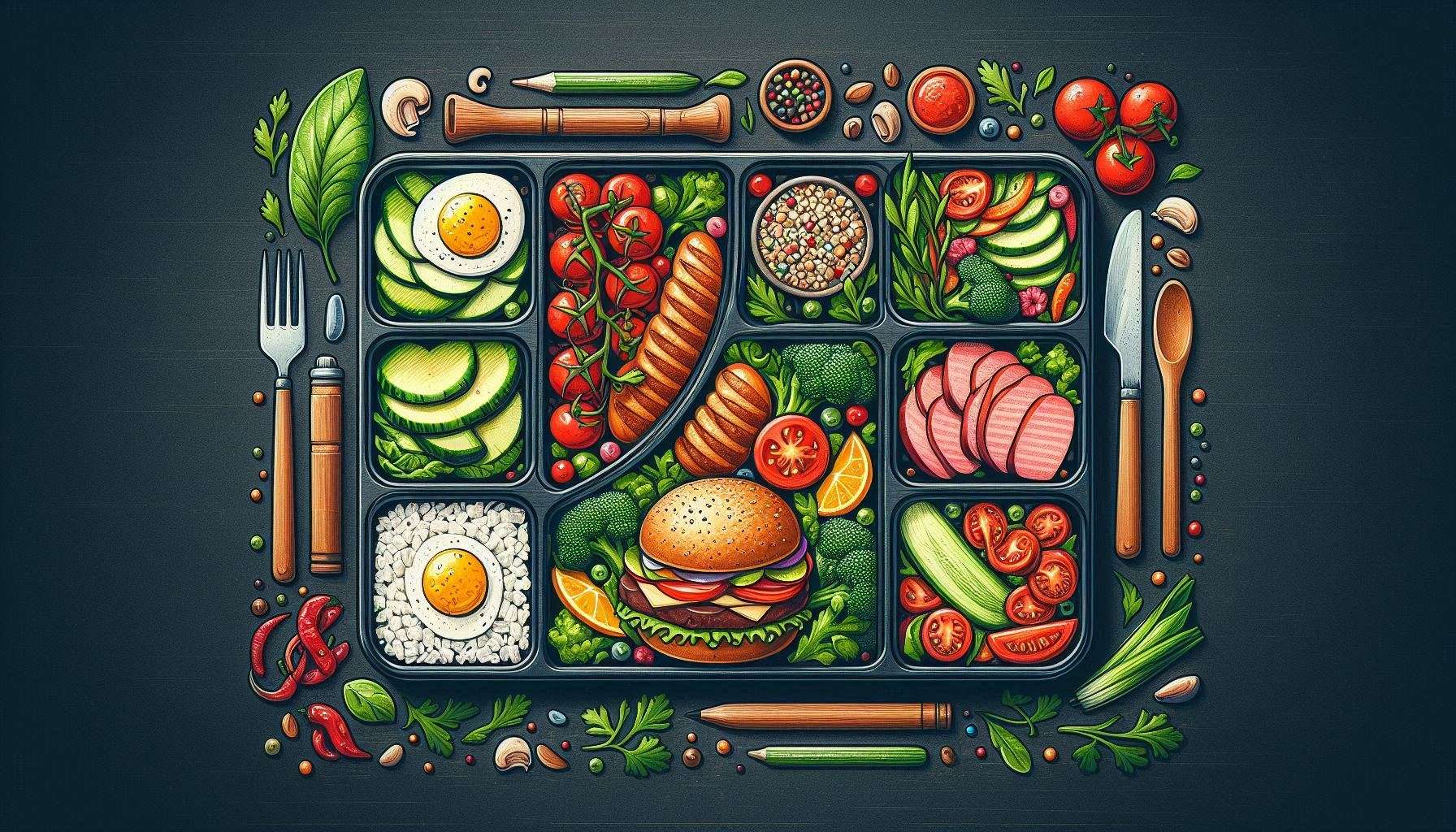Introduction to meal prep like a pro, the ultimate guide to healthy and delicious meals on the go, designed to help you master the art of meal preparation and take control of your diet. With meal prep like a pro, you can ensure that you’re fueling your body with the nutrients it needs to thrive, while also saving time and money in the process.
Meal prep like a pro is not just about cooking meals in advance, it’s about creating a tailored plan that suits your lifestyle, dietary needs, and preferences. By incorporating meal prep into your daily routine, you can experience the benefits of healthy eating, improved energy levels, and a reduced risk of chronic diseases. Whether you’re a busy professional, a student, or an athlete, meal prep like a pro is the perfect solution for anyone looking to take their health and wellness to the next level.
Meal Prep Like a Pro: Tips for Healthy, Delicious Meals on the Go
In our fast-paced world, maintaining a healthy diet can feel like an uphill battle. Between demanding work schedules, family commitments, and the constant temptation of quick-fix takeout, nutritious eating often takes a backseat. But what if there was a simple, effective strategy to reclaim control over your meals, save time and money, and consistently fuel your body with wholesome goodness? Enter meal prep.
Meal prepping is more than just cooking in advance; it’s a lifestyle hack that transforms your approach to food. It’s about strategic planning, efficient cooking, and smart storage, all designed to ensure you have healthy, delicious meals on the go, ready whenever hunger strikes. Whether you’re a seasoned chef or looking for meal prepping for beginners, this ultimate guide will equip you with the knowledge and strategies to become a meal prep pro, making healthy eating an effortless part of your routine.
Why Meal Prep? The Abundant Benefits
The popularity of meal prep isn’t just a trend; it’s a testament to its tangible benefits that address many modern challenges related to food.
1. Healthier Eating Habits
This is arguably the most significant benefit. When you have prepped meals ready, you’re less likely to reach for unhealthy, processed options or succumb to impulsive takeout orders.
- Control Ingredients: You know exactly what goes into your food, allowing you to prioritize fresh, whole ingredients and avoid excessive sugar, unhealthy fats, and artificial additives.
- Nutrient Optimization: Easily incorporate a wide variety of vegetables, lean proteins, and complex carbohydrates, ensuring balanced nutrition. This is especially beneficial for those focusing on a gut-friendly meal prep plan, ensuring a consistent intake of fiber and diverse plant foods.
- Achieve Health Goals: Whether it’s weight loss meal prep, muscle gain, or managing dietary restrictions (e.g., gluten-free, vegan), meal prepping provides the structure to meet your specific nutritional needs.
2. Time Savings
While meal prep requires an initial investment of time, it dramatically reduces the daily decision-making and cooking effort.
- Fewer Daily Chores: Instead of cooking multiple times a day, you consolidate your cooking into one or two sessions.
- Streamlined Process: Chopping vegetables once for several meals, cooking large batches of grains or proteins – this efficiency saves hours throughout the week.
- Grab-and-Go Convenience: Meals are ready when you are, perfect for busy mornings or late evenings.
3. Financial Savings
Eating out frequently or relying on convenience foods can quickly drain your wallet. Meal prepping is a powerful way to save money meal prep.
- Reduced Restaurant Bills: Fewer spontaneous takeout orders mean more money stays in your pocket.
- Smart Grocery Shopping: Planning your meals leads to a precise shopping list, reducing impulse buys and food waste.
- Bulk Buying: You can strategically purchase ingredients in larger, more cost-effective quantities.
4. Stress Reduction
The daily question of “What’s for dinner?” can be a significant source of stress. Meal prep eliminates this decision fatigue.
- Decision Fatigue Eliminated: No more last-minute scrambling or unhealthy compromises.
- Consistent Nutrition: Knowing your meals are planned and ready provides peace of mind.
- Better Energy Levels: Consistent, nutritious meals help stabilize blood sugar and energy, reducing afternoon slumps.
5. Portion Control & Weight Management
Pre-portioning meals is a game-changer for those managing their weight.
- Accurate Servings: You can measure out precise portions, making it easier to stick to calorie or macro goals.
- Mindful Eating: Reduces the temptation to overeat from large serving dishes.
6. Reduced Food Waste
Planned shopping and using ingredients across multiple meals minimizes spoilage.
- Ingredient Utilization: You buy exactly what you need and use it efficiently.
- Creative Leftovers: Leftovers are intentionally incorporated into future meals, rather than forgotten.
Getting Started: The Fundamentals of Meal Prep
Ready to dive in? Here’s what you need to consider before you start chopping.
1. Mindset Shift: From Chore to Empowerment
View meal prep not as another chore, but as an investment in your health, time, and finances. It’s about proactive self-care.
2. Assessing Your Needs and Goals
Your meal prep plan should align with your lifestyle.
- Goals: Are you aiming for weight loss, muscle gain, specific dietary adherence (e.g., vegan, low-carb), or simply healthier eating?
- Time Commitment: How much time can you realistically dedicate to prepping each week (e.g., 1-2 hours on a Sunday)?
- Budget: Set a realistic grocery budget and stick to it.
- Number of Meals: Do you need breakfast, lunch, dinner, and snacks prepped, or just lunches for work? Start small if you’re a beginner.
3. Essential Tools & Equipment
Having the right gear makes the process smoother and more efficient.
- Quality Meal Prep Containers: Invest in airtight, leak-proof containers. Glass is preferred for durability, non-staining, and microwave/oven safety. Look for divided containers for complete meals.
- Sharp Knives & Cutting Boards: Essential for efficient and safe chopping.
- Large Pots & Pans: For batch cooking grains, proteins, and vegetables.
- Food Scale: Crucial for accurate portion control, especially for weight management goals.
- Food Processor/Blender: Speeds up chopping, making sauces, or blending soups.
- Sheet Pans: Ideal for roasting multiple vegetables or proteins at once.
4. Food Safety: Non-Negotiable!
Proper food handling and storage are paramount to prevent foodborne illness.
- Wash Hands: Always wash hands thoroughly before and during food prep.
- Separate Raw & Cooked: Use separate cutting boards and utensils for raw meats/poultry/fish and ready-to-eat foods.
- Cook to Proper Temperatures: Use a food thermometer to ensure meats are cooked safely.
- Rapid Cooling: Cool cooked food quickly before refrigerating (within 2 hours). Divide large batches into smaller containers to speed cooling.
- Storage Guidelines: Most prepped meals are safe in the refrigerator for 3-4 days. Freezing extends shelf life significantly (up to 3 months for many items).
- Reheating: Reheat food thoroughly to an internal temperature of 165°F (74°C).
The Meal Prep Process: Your Step-by-Step Guide
Follow these steps to streamline your weekly meal prep session.
Step 1: Plan Your Meals (The Brainstorming Phase)
This is where the magic begins. Dedicate 15-30 minutes to planning.
- Choose Recipes: Select 2-4 recipes that you enjoy and that align with your goals. Look for easy meal prep ideas that can be scaled up.
- Consider Dietary Needs: If you’re focusing on a gut-friendly diet plan, ensure your recipes include plenty of diverse fiber, prebiotics, and perhaps some fermented elements.
- Theme Days (Optional): Some people like “Taco Tuesday” or “Pasta Wednesday” to simplify choices.
- Variety is Key: While batch cooking is efficient, avoid eating the exact same meal every day to prevent boredom. Plan for slight variations (e.g., different sauces, spices, or add-ins).
- Leverage Leftovers: Can dinner become tomorrow’s lunch? Plan for this to maximize efficiency.
Step 2: Create Your Shopping List
Once your meals are planned, compile a detailed list.
- Categorize: Group items by grocery store aisle (produce, dairy, pantry, meats) to save time.
- Check Pantry First: Avoid buying duplicates by checking what you already have.
- Quantify: Specify quantities (e.g., “2 lbs chicken breast,” “1 head broccoli”).
Step 3: Grocery Shopping
Stick to your list! This prevents impulse buys and helps you save money meal prep.
- Shop Smart: Look for sales on staples like grains, proteins, and produce.
- Bulk Buying: Purchase non-perishables (oats, rice, dried beans) and freezer-friendly proteins in larger quantities if you have storage space.
Step 4: Prep & Cook (The “Power Hour” or “Power Hours”)
This is where the actual work happens. Put on some music or a podcast and get to it!
- Wash & Chop Produce: Wash all fruits and vegetables. Chop onions, peppers, carrots, etc., for the week’s meals. Store them in airtight containers.
- Cook Grains: Batch cook staples like quinoa, brown rice, or farro. These are versatile bases.
- Cook Proteins: Bake chicken breasts, grill fish, cook ground turkey, or prepare a large batch of lentils or chickpeas.
- Batch Cooking Strategies:
- One-Pot/Sheet Pan Meals: Simplify cooking by roasting proteins and vegetables together on a single sheet pan.
- Instant Pot/Slow Cooker: Great for hands-off cooking of grains, stews, or shreddable meats.
- Component Prep vs. Full Meals:
- Component Prep: Prepare individual ingredients (e.g., cooked chicken, roasted veggies, cooked quinoa). This offers flexibility to mix and match throughout the week, reducing boredom.
- Full Meals: Assemble complete meals in individual containers. This is ideal for grab-and-go convenience but offers less flexibility.
Step 5: Portion & Store
Proper storage is critical for freshness and food safety.
- Cool Down Food Safely: Never put hot food directly into the refrigerator, as it can raise the internal temperature of the fridge and create a breeding ground for bacteria. Let food cool to room temperature (within 2 hours) before portioning and refrigerating.
- Use Appropriate Containers: Portion meals into your airtight meal prep containers.
- Labeling: Label containers with the meal name and date. This helps with rotation and food safety.
- Refrigeration & Freezing:
- Refrigerator: Most prepped meals are good for 3-4 days. Plan to eat the most perishable items first.
- Freezer: For longer storage (up to 3 months for many items), freeze individual portions. Soups, stews, cooked grains, and many cooked proteins freeze well. Ensure containers are freezer-safe.
Advanced Meal Prep Strategies & Techniques
Once you’ve mastered the basics, consider these strategies to elevate your weekly meal prep.
1. Batch Cooking for Versatility
Instead of full meals, focus on cooking large quantities of versatile components.
- Proteins: Shredded chicken, ground meat, roasted chickpeas, hard-boiled eggs.
- Grains: Quinoa, brown rice, farro, couscous.
- Roasted Vegetables: Broccoli, bell peppers, zucchini, sweet potatoes.
- Sauces/Dressings: Prepare a large batch of homemade dressing, hummus, or a flavorful sauce to add variety.
Benefit: This allows you to mix and match throughout the week, preventing meal fatigue. For example, shredded chicken can go into wraps, salads, or mixed with rice.
2. Freezer-Friendly Meal Prep
Maximize your freezer space for ultimate convenience.
- Soups & Stews: Portion into freezer-safe containers or bags.
- Chili & Curries: Excellent for freezing.
- Cooked Grains: Freeze cooked rice or quinoa in individual portions.
- Baked Goods: Muffins, energy balls, or even pre-portioned smoothie packs.
- Raw Prep: Chop vegetables and portion them for stir-fries or soups, ready to cook from frozen.
Tip: Label everything with the date and contents. Thaw in the refrigerator overnight or use microwave/stove for reheating.
3. No-Cook or Minimal-Cook Prep
For those truly short on time, some meals require very little cooking.
- Overnight Oats: Prepare jars of oats, milk, chia seeds, and fruit for quick breakfasts.
- Salad Jars: Layer dressing at the bottom, then hard vegetables, grains, protein, and leafy greens on top.
- Wraps/Sandwiches: Prep fillings and assemble daily, or prep components for quick assembly.
- Snack Boxes: Portion out nuts, seeds, fruit, veggie sticks, and hummus.
4. Theme-Based Meal Prep
Simplify planning by focusing on a culinary theme for the week.
- Mediterranean: Quinoa, roasted vegetables, hummus, grilled chicken/fish.
- Asian-Inspired: Brown rice, stir-fried veggies, tofu/chicken, peanut sauce.
- Mexican: Brown rice, black beans, salsa, corn, seasoned ground meat/lentils.
Benefit: Helps with ingredient overlap and keeps flavors cohesive.
Tips for Success & Avoiding Burnout
Consistency is key, but so is preventing meal prep fatigue.
- Start Small: Don’t try to prep every single meal for the entire week on your first go. Start with just lunches, or just dinners, and build from there.
- Embrace Variety: Even with batch cooking, vary your spices, sauces, and toppings to keep meals exciting. Don’t be afraid to try new meal prep recipes.
- Don’t Aim for Perfection: Some weeks will be better than others. It’s okay if you don’t prep every single meal. Any prep is better than no prep.
- Listen to Your Body: Pay attention to what foods make you feel good and energetic. Adjust your plan based on your body’s needs and preferences.
- Involve Family: Get kids or partners involved in the planning, shopping, or prepping. It makes it a shared effort and teaches valuable skills.
- Leverage Leftovers Smartly: Plan for leftovers from dinner to become lunch the next day. This is a simple form of meal prep.
- Invest in Quality Ingredients: Fresh, high-quality ingredients not only taste better but also provide superior nutrition.
- Stay Flexible: Life happens. If your plans change, adapt your meal prep. Maybe you freeze what you prepped or adjust your next week’s plan.
Troubleshooting Common Meal Prep Challenges
Even pros face hurdles. Here’s how to tackle common meal prep issues.
- “My Food Gets Soggy/Boring!”:
- Solution: Separate wet and dry ingredients. Store dressings, sauces, and crispy toppings (like croutons or nuts) separately and add just before eating. For salads, layer ingredients carefully. Vary flavors with different spices, herbs, and healthy sauces.
- “I Don’t Have Enough Time!”:
- Solution: Start smaller (e.g., just prep breakfasts or snacks). Utilize shortcuts like pre-chopped veggies, rotisserie chicken, or frozen grains. Focus on component prep rather than full meals.
- “I Run Out of Ideas!”:
- Solution: Follow meal prep blogs or accounts for inspiration. Use seasonal produce. Revisit old favorites. Keep a list of your successful meal prep ideas.
- “I’m Worried About Food Safety!”:
- Solution: Adhere strictly to proper cooling, storage, and reheating guidelines. Invest in high-quality, airtight containers. If in doubt, throw it out.
Advanced Meal Prep Concepts (Brief Overview)
For those ready to take their meal prep to the next level:
- Macro Tracking Integration: Precisely calculate and portion meals to meet specific macronutrient (protein, carbs, fat) targets for fitness goals.
- Specialized Diets: Adapt meal prep for highly specific dietary needs like Keto, Paleo, Whole30, or specific allergen-free diets.
- Sous Vide for Proteins: Cook proteins (like chicken breast or steak) to perfect doneness, then chill and store for quick searing or grilling later.
- Vacuum Sealing: Extends the freshness of prepped ingredients and meals, especially for freezing.
Meal prep is a powerful tool that empowers you to take control of your nutrition, time, and budget. It’s an investment in your well-being that pays dividends in convenience, health, and peace of mind. By implementing these strategies, from meticulous planning and efficient cooking to smart storage and continuous adaptation, you can truly meal prep like a pro. Start small, stay consistent, and enjoy the journey to consistently eating healthy, delicious meals on the go, every single day.



https://t.me/s/pt1win/112
Актуальные рейтинги лицензионных онлайн-казино по выплатам, бонусам, минимальным депозитам и крипте — без воды и купленной мишуры. Только площадки, которые проходят живой отбор по деньгам, условиям и опыту игроков.
Следить за обновлениями можно здесь: https://t.me/s/reitingcasino
https://t.me/iGaming_live/4637
https://t.me/iGaming_live/4711
https://t.me/reyting_topcazino/12
https://t.me/s/reyting_topcazino/25
https://t.me/of_1xbet/132
https://t.me/s/ef_beef
https://t.me/officials_pokerdom/3776
https://t.me/s/BeEfCasInO_oFfIcIaLs
https://t.me/dragon_money_mani/43